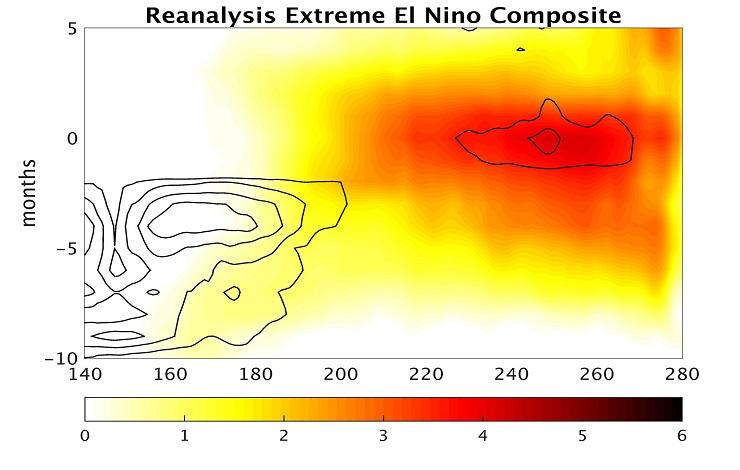Levine, A.F.Z., F.-F. Jin, and M.J. McPhaden (2016): Extreme noise–extreme El Niño: How state-dependent noise forcing creates El Niño-La Niña asymmetry. J. Climate, doi:10.1175/JCLI-D-16-0091.1
Published online. http://journals.ametsoc.org/doi/10.1175/JCLI-D-16-0091.1
A major unanswered question about El Niño-Southern Oscillation (ENSO) is why the largest El Niño events are stronger in magnitude than the largest La Niña events. This paper examines one of the leading hypotheses to explain this asymmetric behavior; namely, that westerly wind bursts (WWBs) create conditions to promote additional WWBs, and the sum total of all the WWBs that occur during the initiation and growth of an El Niño event impacts the eventual magnitude of the event. WWBs are short episodic bursts of westerly winds that occur in the opposite direction of the normal trade winds. These wind bursts push warm water that normally resides in the west Pacific farther to the east, a process that has the potential to increase the size of El Niño events. However, while there are oppositely directed short-term surges of the trade winds, they are not as strong as WWBs and thus do not similarly impact the magnitude of La Niña events.
WWBs can happen randomly since they are related to short-term atmospheric weather events. In this study, the magnitude of the El Niño-La Niña asymmetry is modeled as a function of the increased likelihood of additional WWBs following an initial random WWB. The authors find that the dynamical model simulations of ENSO asymmetry correspond well with the value predicted by the increased likelihood of additional WWBs, and that compared to the reanalysis, most of the models underestimate this likelihood, thereby complicating the simulation of El Niño-La Niña asymmetry and extreme El Niño events. Additionally, using the CMIP5 models’ future projections, the authors find that the difficulties in simulating this asymmetry create significant uncertainty in the projected changes in frequency of extreme El Niño events in future climates.
For more information or to read this article, please visit the Journal of Climate article page here.



